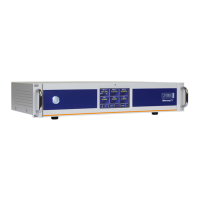MercuryiTC
©2014 Oxford Instruments Omicron NanoScience. All rights reserved.
Page 129
11 AUXILIARY I/O DAUGHTER BOARD
The auxiliary board combines digital inputs and outputs with a stepper motor drive and a PWM
signal. This board is generally used to operate system valves for flow control of gas and
cryogenic liquids.
11.1 Description of the auxiliary I/O board
11.1.1 Auxiliary I/O board functions
The optional auxiliary board performs the following functions:
• It provides a stepper-motor drive and sense input. This can be used to drive an automatic
gas-flow control accessory such as an automatic needle valve on a helium transfer siphon or
variable temperature insert.
• It provides digital inputs that can be used for various functions.
• It provides digital outputs that can be used for various functions (e.g. control of a refill valve).
• It provides a PWM signal proportional to the gas opening.
The auxiliary port connections are made via a 15-way D-socket on the iTC rear panel.
The outputs are open-collector transistors, and each can sink up to 500 mA from a maximum
supply voltage of +25 VDC. If the load is inductive, it is recommended that a diode is connected
across the load to absorb the stored energy.
Low-power loads can be driven directly from pin 15, which is connected to the unregulated 11 V
line via a diode and a fuse. Pin 15 can source a maximum current of 500 mA.
The input lines on the auxiliary port can be driven either by TTL levels or by contact closures
switching to +5 VDC. A 100 kohm pull-down resistor (to 0 V) is fitted to each input.
The AutoGFS sense input must be linked to +5 VDC when an AutoGFS iTC is connected.
If a temperature switch is fitted, it must be connected so that an over-temperature condition
pulls the input above +2.5 VDC. The internal 100 kohm resistor may be shunted by an external
resistor, if required to match the input to a sensor characteristic.

